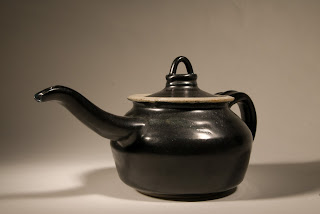 |
| {Earthy Element} |
Sitting with 25 year young potter, Kent Ari Turtz, he jokingly embraces his acquired nickname gypsy child. Speaking about “doing it for the first time” and the contributions of his differing families’ dynamics, he’ll steal nothing but your heart.
Turtz is in no way average-his upright posture helps his already tall stature complimented by a cultivated looking beard. One could become easily distracted with such striking features, but when he speaks, the focus is on his voice. He rarely strays from his matter-of-fact-ly tone. “What was my childhood like?,” a smile stretches across his face, “ I grew up in the care of multiple people. I had au pairs pretty much all of my life. My grandparents on my mom’s side use to call me a gypsy child because I was always traveling around with all these different people.” His upbringing was seasoned with foreign caretakers. His parents were attending medical school throughout his young life. Learning his keeper’s native culture, Turtz credits his foreign experience having heavily influenced his character. Comparing his father’s upbringing to his mother’s, “My dad’s family is kinda’ white bread and my mom’s family is more of the whole grain, with all the little seeds in them.” Even with his parents’ opposing backgrounds, Turtz easily identifies with both the refined and humbled.
He recalls his first encounters with art involving a perspective drawing game played by him and his mother. Naming several of the unexpected possibilities, “…a giraffe that ate a t.v. passing by a window, a sleeping Mexican from a bird’s eye view.” His mother, an artist herself, attributes to Turtz’s primary exposure to art. When questioned who of the sculpture pioneers inspire him and what art era he has found appreciation for; he answers unsurely, “Does Duchamp count,” he pauses, “I really like the Dada movement.” Studying Dadaism’s performance in his academic career has opened his eyes.
Working in several aspects of art, Turtz concerns his work with the physical and not the philosophical. Explaining his technique, he modestly responds, “Because I like to work fast, most of my stuff ends up being—like whatever I do just… that’s what it is. It’s experimental every time I do something; it’s like doing it for the first time.” His work, to the common eye, does not come off as half-assed the way he describes. Providing pottery’s basic history, “…it use to be based of necessity.” He further speaks about his pottery serving the purpose of function rather than an aesthetic stimulant. Even though his intentions are very basic each piece’s result is accidentally beautiful.

Choosing his words wisely to describe his work, Turtz brings his hands to a steeple placing them to his lips; he mutters through them, “…this is a hard one. For lack of a better word: personal, rustic, earthly, raw— use them, I want them to be used until the point of being broken.”
He avoids the proverbial use of the word organic reverting to the appropriation: “…pure.”http://www.myspace.com/hungrypotter




